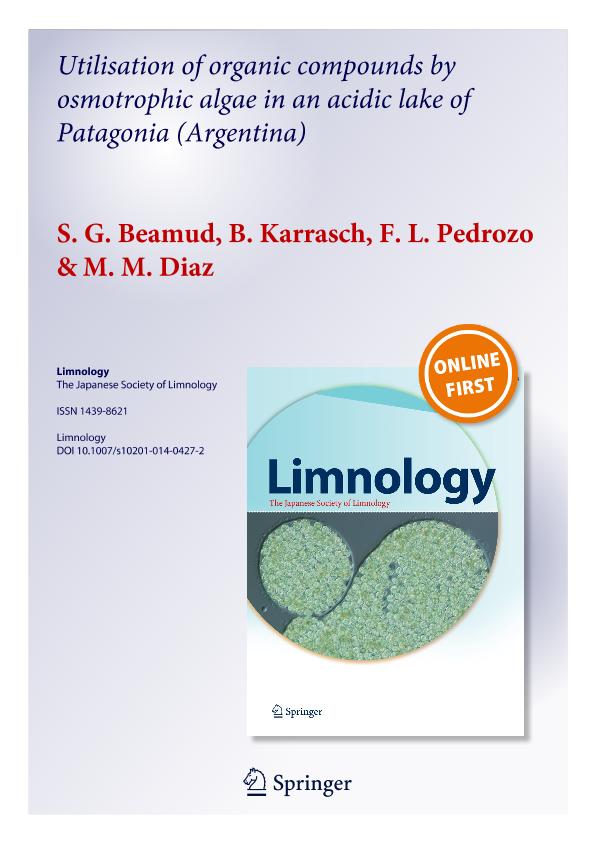Mostrar el registro sencillo del ítem
dc.contributor.author
Beamud, Sara Guadalupe

dc.contributor.author
Karrasch, B.
dc.contributor.author
Pedrozo, Fernando Luis

dc.contributor.author
Diaz, Monica Mabel

dc.date.available
2017-01-27T21:07:16Z
dc.date.issued
2014-04
dc.identifier.citation
Beamud, Sara Guadalupe; Karrasch, B.; Pedrozo, Fernando Luis; Diaz, Monica Mabel; Utilisation of organic compounds by osmotrophic algae in an acidic lake of Patagonia (Argentina); Springer Tokyo; Limnology; 15; 2; 4-2014; 163–172
dc.identifier.issn
1439-8621
dc.identifier.uri
http://hdl.handle.net/11336/12134
dc.description.abstract
We investigated whether algal osmotrophy in naturally acidic Lake Caviahue is an important process for acquisition of organic carbon and organic nitrogen. To accomplish this, we quantified algal assimilation of organic compounds, measured the specific growth rate and biomass yield, and documented incorporation of organic compounds by phytoplankton in situ using microautoradiography. Substrate uptake quantification and microautoradiographic investigations were performed using 3 H-leucine, 3 H-glucose, 3 H-thymidine, 14C-aspartic acid, 14C-acetic acid and 14C-bicarbonates. The results showed that the most important species of the phytoplankton community, Keratococcus rhaphidioides and Watanabea sp., took up various sources of organic carbon and nitrogen under both light and dark conditions. They were also able to assimilate leucine, thymidine, aspartic acid and acetate under high levels of inorganic nitrogen and phosphorus, while they could use leucine, arginine, glutamine and glucose under low levels of nitrogen and phosphorus. The assimilation rates were higher in light than in darkness, and the algal specific growth rates increased when organic sources were added. We proposed that osmotrophy complements the main photosynthetic process of the phytoplankton in Lake Caviahue, which helps to overcome the scarcity of light and inorganic nitrogen and carbon in the water column.
dc.format
application/pdf
dc.language.iso
eng
dc.publisher
Springer Tokyo

dc.rights
info:eu-repo/semantics/openAccess
dc.rights.uri
https://creativecommons.org/licenses/by-nc-sa/2.5/ar/
dc.subject
Osmotrophy
dc.subject
Acidic Lake
dc.subject
Keratococcus
dc.subject.classification
Biología Marina, Limnología

dc.subject.classification
Ciencias Biológicas

dc.subject.classification
CIENCIAS NATURALES Y EXACTAS

dc.title
Utilisation of organic compounds by osmotrophic algae in an acidic lake of Patagonia (Argentina)
dc.type
info:eu-repo/semantics/article
dc.type
info:ar-repo/semantics/artículo
dc.type
info:eu-repo/semantics/publishedVersion
dc.date.updated
2016-12-12T14:27:39Z
dc.identifier.eissn
1439-863X
dc.journal.volume
15
dc.journal.number
2
dc.journal.pagination
163–172
dc.journal.pais
Japón

dc.journal.ciudad
Tokyo
dc.description.fil
Fil: Beamud, Sara Guadalupe. Consejo Nacional de Investigaciones Científicas y Técnicas. Centro Científico Tecnológico Patagonia Norte. Instituto de Investigación en Biodiversidad y Medioambiente; Argentina. Universidad Nacional del Comahue; Argentina
dc.description.fil
Fil: Karrasch, B.. Helmholtz Centre For Environmental Research; Alemania
dc.description.fil
Fil: Pedrozo, Fernando Luis. Consejo Nacional de Investigaciones Científicas y Técnicas. Centro Científico Tecnológico Patagonia Norte. Instituto de Investigación en Biodiversidad y Medioambiente; Argentina. Universidad Nacional del Comahue; Argentina
dc.description.fil
Fil: Diaz, Monica Mabel. Consejo Nacional de Investigaciones Científicas y Técnicas. Centro Científico Tecnológico Patagonia Norte. Instituto de Investigación en Biodiversidad y Medioambiente; Argentina. Universidad Nacional del Comahue; Argentina
dc.journal.title
Limnology

dc.relation.alternativeid
info:eu-repo/semantics/altIdentifier/doi/http://dx.doi.org/10.1007/s10201-014-0427-2
dc.relation.alternativeid
info:eu-repo/semantics/altIdentifier/url/http://link.springer.com/article/10.1007%2Fs10201-014-0427-2
Archivos asociados
